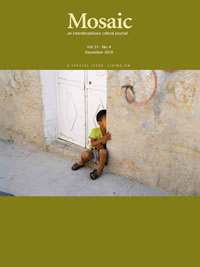Issue 51.4
Overview

Special Issue: Living On
Published: December 2018
View the issue introduction or see the issue summary and contents below.
10 essays, totalling 192 pages
$24.95 CAD
This special issue of Mosaic celebrates the journal’s 50th anniversary and gathers together a number of papers and events presented at a symposium to mark that occasion. The symposium, titled Living On, was initiated by Dawne McCance and held at the University of Manitoba on March 9-11, 2017. The theme and title come from Jacques Derrida’s “Living On: Borderlines” (1979) and were to acknowledge a range of issues including the journal’s interdisciplinary mandate, Mosaic’s own recent conference on lifedeath (48.1-48.4), and the increasingly fraught and troubled times that we all face. More pragmatically still, Living On was to point to the journal’s next half-century and its life under a new editor in the wake of McCance’s seventeen years at the helm. Finally, Living On was to showcase the critical work of select participants from a diverse set of fields from which Mosaic welcomes contributions.
Lidwien van de Ven: Living OnLidwien van den Van In conjunction with Mosaic’s 50th Anniversary Symposium, Living On, the University of Manitoba School of Art Gallery presented the photographic work of Lidwien van de Ven. The installation was van de Ven’s first solo exhibition in North America. | |
Lidwien van de Ven’s Ramallah, 11:09:06 (boy sitting): or, The Chances of ConcealmentDavid Farrell Krell What follows is a highly personal response to one of Lidwien van de Ven’s photographs in the Lidwien van de Ven: Living On exhibition at the University of Manitoba School of Art Gallery. Readers will soon recognize the truth of what I openly confess here at the outset: I have no competence in art criticism, and I am no more than an amateur photographer myself. I am writing about this photograph simply because I find it compelling. To my surprise, it elicits from me thoughts about the poetry of Friedrich Hölderlin and Georg Trakl, thoughts that hear strains of Gustav Mahler’s Kindertotenlieder. | |
On the Possibility and Impossibility of a WorldAntonio Calcagno How does a world continue to persist? This essay argues that the primary way that a world continues to persist is through its affect, which is disclosed in the very intimacy of what Michel Henry and other phenomenologists call auto-affection. The disclosure of a world like the manifestation of the self is revealed in a primary experience of auto-affection. The revelation of a world persists because of its primary impression upon us through the sensations, feelings, and meanings it elicits in us. Our continued response to the primary sensations, feelings, and meanings, which are grasped even before we are fully conscious of them, and which the world affects in us, allows the world to persist and unfold in time. | |
In Spite of the WorldDiane Enns How are we to live in spite of a world we may not love? With the help of Hannah Arendt this essay reflects on possible deserts, whether political, social, or institutional, and on the oases that we need to survive them. | |
Moving On/Living On. . . Toward a Theory of Improvisation and InterdisciplinarityDaniel Fischlin This essay explores how the social practices associated with musical improvisation engage cocreative forms that catalyze resilience and mobility as conjoined expressions of the human. These improvisatory forms, in turn, provide a radical way of modeling new interdisciplinary methodologies, helping to diversify the ecology of knowledges in the name of living and moving on. | |
Living On—with MonstersDavid Farrell Krell Jacques Derrida remarks that the future awaits us always in the form of monstrosity, by which he means that we can never successfully anticipate the future, much less program it. The monstrous, which defeats all our categories, shows itself to us by disarming us. It also warns us about what may be coming next. If we live on, that is the way we live on. | |
A Hard and Brutal MysticismAlphonso Lingis Why should nature evoke in us any emotion beyond those, such as fear and hunger, that are needed for survival? People love space outside of occupied places, vast dimensions and depths filled with substantiality and vibrancy. They love the immense multitudes of life-forms that exist and grow independently of people. | |
Behind the Scenes of the Derrida Seminars Translation ProjectElizabeth Rottenberg This essay takes the reader behind the scenes of the Derrida Seminars Translation Project (DSTP). It offers two examples of DSTP’s dust-ups over English and suggests that these scenes of serious play not only bring out the stylistic and technical difficulties of translating Derrida, they also echo two earlier scenes of intra-linguistic translation within Derrida’s own texts. That is, this movement back and forth, fort and da, between English and English, translates the back-and-forth movement between French and French, which is further marked, literally marked, becomes remarkably literal, in the passage between the French of Derrida’s seminars and the French of his published texts. | |
QuicksandNicholas Royle This essay explores the nature of the word and concept of "quicksand" across a range of texts and contexts, including the Book of Genesis, Daniel Defoe, Percy Bysshe Shelley, Walt Whitman, Sigmund Freud, Nella Larsen, Maurice Blanchot, Margaret Atwood, David Bowie, and Bear Grylls. Particular attention is given to Jacques Derrida’s “Living On: Borderlines” and The Beast and the Sovereign. | |
Graduate Student PanelAlyson Brickey, Ryan C.P. Fics, Gwynne Fulton, Riley McGuire, and Carrie Reese This graduate student panel, focused on the precarity of living on as graduate students, was held at the Living On symposium held at the University of Manitoba from March 9-11, 2017. |